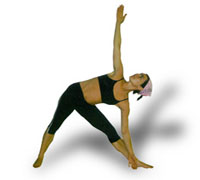7 Steps to a More Serene Life
 Take this quick test: What are the thoughts that typically cross your mind in the course of a day these days? Do they run along the following lines? I’m totally exhausted and my backaches.
Take this quick test: What are the thoughts that typically cross your mind in the course of a day these days? Do they run along the following lines? I’m totally exhausted and my backaches.
- I obsess about problems but can’t seem to develop solutions.
- My heart is racing and my stomach is churning.
- Job/family worries keep me up all night.
- I have a major tension headache.
- My decisions are increasingly fear based and I’m pessimistic about the future.
- I often envy other people’s lives.
- Crazy days leave me with heartburn and indigestion.
- I’m chronically uncertain about my job security because of an unstable work environment.
If you recognize yourself in even a few of these statements, then in all likelihood you have hit the stress ceiling. And it’s not only telling on your mind but also your body. Continue in this fashion and you will have set yourself up for a host of minor and major life threatening diseases (think colds, canker sores, depression, diabetes, high blood pressure…). Which will further add to your stress, and so on and so forth. Before you know it, you are caught in a vicious circle that thrives by feeding on itself.
But you can break free from the stress merry-go-round if you know how.
While few of us have control over when stress will storm into our lives, we can prepare ourselves our bodies and minds for when it hits. With that in mind, we present seven reliable stress reduction techniques, and tips to help you start practicing them. You can learn any of these on your own. And all of them work sometimes in powerful ways. Use the techniques that work best for you, and develop a regular practice.
Stay Mindful
Mindfulness relieves stress by increasing your awareness of your body. “Most of us don’t focus enough on physical sensations, spending too much time caught up in a mental swirl that increases our stress,” says Saki Santorelli, director of the Stress Reduction Clinic in Massachussets. Mindfulness involves focusing attention on parts of your body, starting at your toes. Simply observe sensations in each area, without trying to change them.
sensations, spending too much time caught up in a mental swirl that increases our stress,” says Saki Santorelli, director of the Stress Reduction Clinic in Massachussets. Mindfulness involves focusing attention on parts of your body, starting at your toes. Simply observe sensations in each area, without trying to change them.
What you can do
- Practice in a warm room where you won’t be interrupted. Wear loose clothing.
- Lie down, and try not to fall asleep.
- Start by observing your breathing.
- Concentrate on the big toe on your left foot, noticing any sensations in your toe.
Don’t put a “good” or “bad” label on these sensations; just observe them. - Imagine your breath coming in and out of your toe.
- After a few minutes, when you’re ready to leave your big toe, allow it to fade from your mind. Take a few deep breaths, then move on to the rest of your toes on the left foot, focusing on them as a group. Repeat the process of observing sensations in your toes, without judging the feelings. Imagine breath coming in and out of your toes, then allow them to dissolve in your mind’s eye. Focus on the sole of your foot, your heel, the top of your foot, and your ankle. Move slowly up your left leg, through your body, to the top of your head.
- If your attention wanders, gently direct your mind back to that part of the body and the sensations there. The scan should take 20 to 40 minutes; practice it once a day.
From mindfulness, meditation is just a step away. Meditation is basically a method of focusing on your breath, a thought, or a mantra or spiritual passage to block out surrounding distractions and calm and center your mind. There are many styles, which vary in technique, but most trigger the relaxation response, a physiological state in which breathing slows, the pulse rate decreases, and blood pressure falls.
Keep Negative Thinking At Bay
Negative statements like “I’m not good at my job” or “I always mess things up” damage your self-esteem over time because you begin to believe them. And when your self-esteem dips, you have difficulty coping confidently in stressful situations.
Changing these negative statements has physiological benefits, too, says psychotherapist Lori Leyden-Rubenstein, author of The Stress Management Handbook. Negative self-talk triggers the stress response, causing the body to release adrenaline, cortisol, and steroids. Over time, these hormones can affect multiple systems and organs in your body, “and this is where illness begins,” Leyden-Rubenstein says.
What you can do:
Stop and Listen: Most of us don’t realise that we talk to ourselves constantly. Listen to what you’re saying, particularly when you’re stressed. Plan moments when you stop and tune in to your self-talk. Pause and listen to yourself when you see someone who stresses you your boss, for example.
Breathe: After you’ve tuned in, take a deep breath to relax. Breathe in through the nose, expanding the abdominal area, then exhale through the mouth, letting the abdomen naturally flatten. » Be objective. When the boss calls you into his office, you might assume you’re in trouble. But what basis do you have for assuming that? Cognitive research shows that 99 per cent of all negative self-talk is distorted in some way. Replace that negative thought with a statement based on the facts as you know them. For example, say to yourself, “There’s rarely a problem with my work,” or “I’m good at my job.”
Stay Connected
When you “create community,” you develop a network of friends and acquaintances. “Community” can include a hiking club, a support group for seriously 111 people, even mourners attending a funeral, says Joal Fischer, executive director of Support Works, a clearing house for support groups in Charlotte, North Caroline. “It’s a group of people saying, “You’re not alone,’ that you have the support of other people who care about you. Sound relationships can ease the stress of a serious illness,” he says.
What you can do:
Heal existing relationships: When you face a crisis, shore up primary relationships with your spouse or partner, which can be weakened by the pressure. Counseling can help. With attention, the relationship can be a source of support rather than another stressor to make the situation worse.
Widen your circle of friends: by joining a support group or other community groups like a church or a bhajan. Prayer groups combine social support with the benefits of prayer.
Connect yourself: It’s crucial for a stressed person to seek out support, rather than passively waiting for it, even though this can be tough for a person who’s stressed, particularly if chronic pain or illness is the cause.
Work Up A Sweat
 Whether it’s a brisk walk around the block, an afternoon spent gardening, or a 10-mile bike ride, regular exercise can reduce anxiety, boost your mood, and generally improve and maintain your health. Exercise is included in many stress reduction programs because it has been shown to build self-esteem and release endorphins, brain chemicals that trigger positive feelings. It rids the body of hormones produced during the fight-or-flight response. Additionally, researchers at the University of Georgia found that anxious college students who spent 20 minutes on an exercise bike reported less anxiety because it gave them a break from studying for exams. Researchers say just the timeout from pressing problems helped relieve the women’s stress.
Whether it’s a brisk walk around the block, an afternoon spent gardening, or a 10-mile bike ride, regular exercise can reduce anxiety, boost your mood, and generally improve and maintain your health. Exercise is included in many stress reduction programs because it has been shown to build self-esteem and release endorphins, brain chemicals that trigger positive feelings. It rids the body of hormones produced during the fight-or-flight response. Additionally, researchers at the University of Georgia found that anxious college students who spent 20 minutes on an exercise bike reported less anxiety because it gave them a break from studying for exams. Researchers say just the timeout from pressing problems helped relieve the women’s stress.
What you can do:
- To start with, opt for a low-stress regimen. Exercises that don’t involve intense competition, which can create another source of stress in your life, are best. Find an activity you enjoy (swimming, dancing, walking, cycling) and stick with it.
- Don’t go overboard. Exercise too much, without proper rest and recovery periods, and you’ll risk injuries that can increase your stress.
Go Down On Your Knees
Prayer is the act of communicating with the divine. It can be any activity that helps you feel close to what Larry Dossey, M.D., author of Healing Words: The Power of Prayer and the Practice of Medicine calls “the Absolute.” For some people, this can simply be time outdoors, appreciating nature.
In his book Timeless Healing Herbert Benson, M.D., founding president of the Mind/Body Medical Institute at Harvard Medical School, explains that the repetition of prayers can produce what he calls “the relaxation response,” lowering blood pressure and heart rate, and increasing feelings of serenity. Dossey says the act of relying on a force more powerful than yourself “gives you a sense of confidence that you don’t have to handle your problems alone.”
Even the act of praying on behalf of another person, can reduce stress. Turning your focus away from your own problems to another person’s needs can help you, says Priscilla Ivimey, a counsellor who specializes in stress relief. “If I were to pray for you, I would hold you in my mind and my heart and ask the greater good to offer you whatever it is that you need. That can only help me feel good,” she says. A study by Scan 0 Laoire, clinical psychologist in Los Altos, California, found that subjects who prayed for others 15 minutes a day had improved self-esteem and moods after 12 weeks.
What you can do:
Keep it simple: “It doesn’t matter if you use vthee’ or vthou’; the language is completely secondary,” Dossey says. So is the form the prayer takes. “As long as you try to make contact with something outside of yourself and do it sincerely, that’s prayer,” he says.
Start small: A simple ‘thank you’ first thing in the morning or after meals is small but meaningful, Dossey says.
Don’t focus on relief: While prayer may decrease the effects of stress, research shows that it’s less effective to pray in order to reduce your blood pressure or get rid of a tension headache. “When we meditate or pray for that kind of goal, we’ re ultimately shooting ourselves in the foot. It interferes with the genuineness of the effort,” he says. Instead view stress relief as secondary to the practice.
Turn To Yoga
Yoga can reduce the impact of stress by increasing muscle flexibility. When we are stressed, our muscles respond by tightening, and yoga postures can counteract that tightenings, says Jnani Chapman, registered nurse and acting executive director of the International Association of Yoga Therapists. Deep yoga breathing also alleviates the stress response by changing the blood chemistry. When you exhale twice as long as you inhale, you expel more carbon dioxide, and the change in the oxygen and carbon dioxide ratio in the blood causes the parasympathetic nervous system to trigger the relaxation response.
What you can do
Try these three poses. Wear loose, comfortable clothing, remove your shoes, and practice the poses on a mat on the floor. Pay attention to your physical limits, and the sensations of these limits (such as tingling or warmth). Try not to exceed them. Concentrate on what your body can do, instead of what it can’t.
Bridge Pose: Lie on your back with your feet flat on the floor and your knees bent and pointing to the ceiling. Place your feet hip-width apart and your arms, palms down, next to your body. Lift your abdomen toward the ceiling, as if a marionette string were pulling you upward through your navel. Your weight will shift to rest on your upper back and the back of your neck and head. Watch your breath moving in and out of your abdomen. Hold this position for one minute (or for as long as you can). Slowly lower your back toward the floor, rolling it down one vertebra at a time.
The Cat: Get down on the floor on your hands and knees, with your arms and thighs perpendicular to the floor. Exhale, retract your abdominal muscles, and arch your back like a cat, allowing your head to drop forward, your chin toward your chest. Inhale and release your back so it sags downward. Raise your head so you’re looking straight ahead. Move between the arching and sagging motions slowly, but without pausing in either position. Repeat this sequence 10 times.
Child’s Pose: Kneel on the floor, then sit your buttocks on your heels. Lower your torso onto your lap, resting your forehead on the floor. Rest your arms next to your body, palms up. Allow your body to settle into this position. Hold for a few seconds or until you feel relaxed. Breathe normally.
Eat Serene Cuisine
What you eat makes a difference in how you cope. Here’s how to streamline your diet:
AVOID
Caffeine: This stimulant found in coffee, colas, tea interferes with sleep and triggers the release of adrenaline, a stress hormone.
Alcohol: Typically known as a sedative, alcohol can, in fact, intensify anxiety and irritability.
Refined sugar: It digests quickly, raising blood sugar levels dramatically. The resulting blood sugar swings can make you feel weak, lethargic, and less able to deal with stress.
GET MORE OF
 Complex carbohydrates and high-protein foods. Whole grains, vegetables, beans and nuts all raise blood sugar levels gradually, then stabilize them. But protein blocks production of serotonin (a sleep inducers), so avoid too much protein at dinner to get a good night’s rest.
Complex carbohydrates and high-protein foods. Whole grains, vegetables, beans and nuts all raise blood sugar levels gradually, then stabilize them. But protein blocks production of serotonin (a sleep inducers), so avoid too much protein at dinner to get a good night’s rest.
Water: One of the first signs of dehydration is fatigue, which can exacerbate stress. Drink up.
Vitamin B5: Strengthens the adrenal gland, fatigued by the stress response. Food sources: yeast, legumes, wheat germ, oatmeal.
Vitamin B6: Helps produce prostaglandin’s, which relax smooth muscle tissue. A deficiency causes irregular sleep patterns. Food sources: brown rice, bananas, sunflower seeds, leafy green vegetables, and raisins.
Vitamin C: Boosts immunity, fights fatigue. Food sources: fruits and vegetables.
Magnesium: Helps produce prostaglandin’s. A deficiency leads to an overproduction of lactic acid, which exacerbates stress. Food sources: leafy green, beans, nuts and seeds, tofu, raisins, dried figs, millet.
Zinc: Helps your body absorb B vitamins, balances high blood sugar levels. Good sources: wheat germ, pumpkin seeds, whole grain products, wheat bran, high-protein foods.
Iron: Women, especially, are iron deficient in their childbearing years, which makes them more vulnerable to stress, because it increases fatigue. Good sources include lean red meat, leafy greens.





























